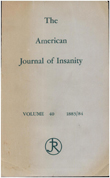Comorbid Tourette's disorder and bipolar disorder: an etiologic perspective
Abstract
OBJECTIVE: Using an epidemiologic approach, the authors attempt to elucidate relationships between Tourette's disorder and bipolar disorder. METHOD: Of 205 patients with Tourette's disorder in the North Dakota Longitudinal Tourette Syndrome Surveillance Project, 15 had comorbid bipolar disorder. A subset of the patients with Tourette's disorder had been included in earlier population-based prevalence studies of Tourette's disorder in children, adolescents, and adults. Minimal risk ratios were calculated for the patients with Tourette's disorder plus bipolar disorder by age group (children/adolescents and adults). This information was used to estimate genetic risk indicators for comorbid Tourette's disorder and bipolar disorder. RESULTS: The estimated risk of developing bipolar disorder among the study group of children, adolescents, and adults with Tourette's disorder was more than four times higher than the level expected by chance, but this finding did not reach statistical significance. It was indicative of trends, however. CONCLUSIONS: Comorbidity between Tourette's disorder and bipolar disorder does not appear to be due to chance co-occurrence of the two disorders. Although a genetic mechanism may play a causal role, in the absence of family studies an explanatory model involving the concept of canalization of basal-ganglia-mediated dysfunctions is offered. In such a construct, Tourette's disorder would be a likely accompaniment to other conditions, including bipolar disorder, whose pathogenic determinants might channel through neural pathways involving the basal ganglia. The presence of significant developmental disabilities may further enhance factors culminating in comorbid Tourette's disorder and bipolar disorder.
Access content
To read the fulltext, please use one of the options below to sign in or purchase access.- Personal login
- Institutional Login
- Sign in via OpenAthens
- Register for access
-
Please login/register if you wish to pair your device and check access availability.
Not a subscriber?
PsychiatryOnline subscription options offer access to the DSM-5 library, books, journals, CME, and patient resources. This all-in-one virtual library provides psychiatrists and mental health professionals with key resources for diagnosis, treatment, research, and professional development.
Need more help? PsychiatryOnline Customer Service may be reached by emailing [email protected] or by calling 800-368-5777 (in the U.S.) or 703-907-7322 (outside the U.S.).



